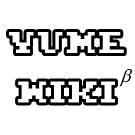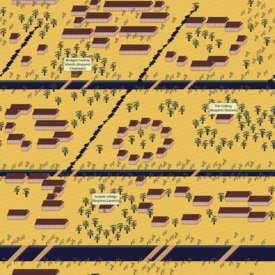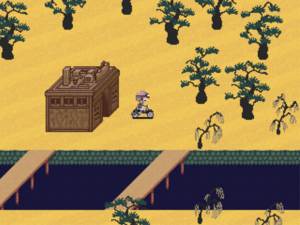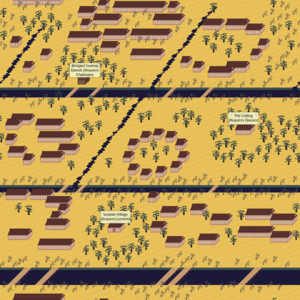>Cyan0110 No edit summary |
SalmSamuel (talk | contribs) mNo edit summary |
||
| (51 intermediate revisions by 24 users not shown) | |||
| Line 1: | Line 1: | ||
{{Locationbox | |||
|headercolor = # | |headercolor = #ebca5b | ||
|headerfontcolor = # | |headerfontcolor = #906a4f | ||
|image = Mose1. | |image = Mose1.PNG | ||
| | |JapaneseName = 平安小町 | ||
|Name = ''Heian Komachi'', Heian (period) Small Town | |||
|Effects = None | |Effects = None | ||
|Wallpapers = WP #180 | |Wallpapers = WP #180, WP #712 | ||
|Events = None | |Events = None | ||
|NPCS = | |NPCS = None | ||
|Connections = | |Connections = {{Connection|Bridged Swamp Islands|effects_needed=Chainsaw}}, {{Connection|Seaside Village|effects_needed=Lantern}}, {{Connection|The Ceiling|effects_needed=Glasses}}, {{Connection|Misty Streets|effects_needed=Invisible|one_way_type=NoReturn}} | ||
|BGM = | |BGM = {{BGM|title=qs0UrDFJ-bgm060|filename=Qs0UrDFJ-bgm060-slow.ogg|soundroom=041B|speed=80}}, {{BGM|title=n3-FiT|filename=Heian Era Village Aquarium Passage (n3-FiT).ogg|label=Terrarium Passage|speed=90}} | ||
''' | |Map ID = 0661, 0669, 0670 | ||
|Primary = Mosenite | |||
|VersionAdded = 0.102e | |||
}} | |||
'''Heian Era Village''', formerly named ''Mosenite'', is a classical Japanese painting style village, reminiscent of paintings of the [[wikipedia:Heian period|Heian era]], that can be entered by [[Yume 2kki:Effects#Chainsaw|chainsawing]] the bouncy snake in the wooden house from [[Yume 2kki:Bridged Swamp Islands|Bridged Swamp Islands]] or lighting the candle in [[Yume 2kki:Seaside Village|Seaside Village]]. | |||
{{LocationMap|filename=mosenite_village.png|caption=Map of Heian Era Village.}} | |||
==Features== | ==Features== | ||
When reaching the village, you'll notice sand covering the entire area, as well as dozens of Japanese black pines, some of them being healthy and others being withered. Near the house [[Yume 2kki:Urotsuki|Urotsuki]] exited is a river that can be crossed thanks to the wooden bridge. This river is connected to various streams, passing near many tradional houses. | |||
Re-entering the house Urotsuki came from will lead to an alternate room, where the flowers became withered trees and the snake is replaced by a dark creature. Chainsawing it will lead her back to the Bridged Swamp Islands. | |||
Walking along the river, then crossing a bridge and going south-east to a circle of trees will lead Urotsuki to a house that can be entered from the front doorway. Inside of it is a small terrarium with plants growing in it. At the end of this terrarium is a door that happens to be locked when you interact with it. However, equipping the [[Yume 2kki:Effects#Glasses|Glasses]] effect will allow Urotsuki to open it, reaching [[Yume 2kki:The Ceiling|The Ceiling]] throught it. | |||
Traveling west from that building leads her to a circle of houses, where one of the trees is home to what looks like a beige cockerel with a long tail that can be stopped with the [[Yume 2kki:Effects#Crossing|Crossing]] effect. North of this area is another circle of houses, one of the smaller of which will have a door, letting you get in. This house is almost empty, except for a tree and a mirror. Using the [[Yume 2kki:Effects#Invisible|Invisible]] effect will make a shape appear in it, and interacting with it in this state will make a lamprey-like figure emerge out of it, taking Urotsuki to [[Yume 2kki:Misty Streets|Misty Streets]]. | |||
If she continues south instead, crossing another bridge and then walk south-west, she will reach another house surrounded by trees. The pink door on its facade can be entering, leading to a small room with a candle. Lighting it with the [[Yume 2kki:Effects#Lantern/Torch|Lantern]] effect will stop the music. Exiting the house will bring Urotsuki in [[Yume 2kki:Seaside Village|Seaside Village]]. | |||
==Directions== | ==Directions== | ||
Nexus → [[Red Streetlight World]] → [[Bridged Swamp Islands]] → | With the [[Yume 2kki:Effects#Chainsaw|Chainsaw]] effect: | ||
*The Nexus → [[Yume 2kki:Red Streetlight World|Red Streetlight World]] → [[Yume 2kki:Bridged Swamp Islands|Bridged Swamp Islands]] → '''Heian Era Village''' | |||
==Trivia== | ==Trivia== | ||
* | *Heian Era Village is one of the three worlds to be named in Japanese after its creator, from its internal name, and was one of the two worlds to be named in English after its creator. In Japanese, the others are [[Yume 2kki:Ecstasy World|Ecstasy World]] and [[Yume 2kki:Fabric World|Fabric World]]; In English, the other is [[Yume 2kki:GALAXY Town|GALAXY Town]]. | ||
**This internal naming is a result of the area being the first in the batch of maps allocated to the author, in which the map is labeled with the author's name for distinction between other map hierarchies belonging to their respective authors. | |||
==Gallery== | |||
<gallery> | |||
Aqua1. | MoseniteAltConnection.PNG|You've... changed. | ||
Mosenite1.PNG | |||
Mosenite3.PNG | |||
MoseniteTo2.PNG|The house leading to the terrarium. | |||
Aqua1.PNG|The small terrarium, with a door leading to [[Yume 2kki:The Ceiling|The Ceiling]] at the end. | |||
Mosenite2.PNG | |||
MoseniteTo1.PNG|The other house, leading to the candle room. | |||
</gallery> | </gallery> | ||
Latest revision as of 01:06, 27 August 2024
| Heian Era Village | |||||||||||
|---|---|---|---|---|---|---|---|---|---|---|---|
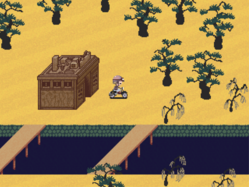
| |||||||||||
| Basic Info | |||||||||||
| Japanese Name(s) |
平安小町 | ||||||||||
| Effects | None | ||||||||||
| Collectibles |
WP #180 | ||||||||||
| Events | None | ||||||||||
| Notable NPCs | None | ||||||||||
| Other | |||||||||||
| Connecting Areas | Bridged Swamp Islands ✨ Seaside Village ✨ The Ceiling ✨ Misty Streets ✨ ➡️ | ||||||||||
| BGM | 🔊 qs0UrDFJ-bgm060 (No. 041B) 🔊 n3-FiT – Terrarium Passage | ||||||||||
| Map ID | 0661, 0669, 0670 | ||||||||||
| Version Added | 0.102e | ||||||||||
| Author | Mosenite | ||||||||||
| |||||||||||
Heian Era Village, formerly named Mosenite, is a classical Japanese painting style village, reminiscent of paintings of the Heian era, that can be entered by chainsawing the bouncy snake in the wooden house from Bridged Swamp Islands or lighting the candle in Seaside Village.
Features
When reaching the village, you'll notice sand covering the entire area, as well as dozens of Japanese black pines, some of them being healthy and others being withered. Near the house Urotsuki exited is a river that can be crossed thanks to the wooden bridge. This river is connected to various streams, passing near many tradional houses.
Re-entering the house Urotsuki came from will lead to an alternate room, where the flowers became withered trees and the snake is replaced by a dark creature. Chainsawing it will lead her back to the Bridged Swamp Islands.
Walking along the river, then crossing a bridge and going south-east to a circle of trees will lead Urotsuki to a house that can be entered from the front doorway. Inside of it is a small terrarium with plants growing in it. At the end of this terrarium is a door that happens to be locked when you interact with it. However, equipping the Glasses effect will allow Urotsuki to open it, reaching The Ceiling throught it.
Traveling west from that building leads her to a circle of houses, where one of the trees is home to what looks like a beige cockerel with a long tail that can be stopped with the Crossing effect. North of this area is another circle of houses, one of the smaller of which will have a door, letting you get in. This house is almost empty, except for a tree and a mirror. Using the Invisible effect will make a shape appear in it, and interacting with it in this state will make a lamprey-like figure emerge out of it, taking Urotsuki to Misty Streets.
If she continues south instead, crossing another bridge and then walk south-west, she will reach another house surrounded by trees. The pink door on its facade can be entering, leading to a small room with a candle. Lighting it with the Lantern effect will stop the music. Exiting the house will bring Urotsuki in Seaside Village.
Directions
With the Chainsaw effect:
- The Nexus → Red Streetlight World → Bridged Swamp Islands → Heian Era Village
Trivia
- Heian Era Village is one of the three worlds to be named in Japanese after its creator, from its internal name, and was one of the two worlds to be named in English after its creator. In Japanese, the others are Ecstasy World and Fabric World; In English, the other is GALAXY Town.
- This internal naming is a result of the area being the first in the batch of maps allocated to the author, in which the map is labeled with the author's name for distinction between other map hierarchies belonging to their respective authors.
Gallery
The small terrarium, with a door leading to The Ceiling at the end.
- ebca5b
- 906a4f
